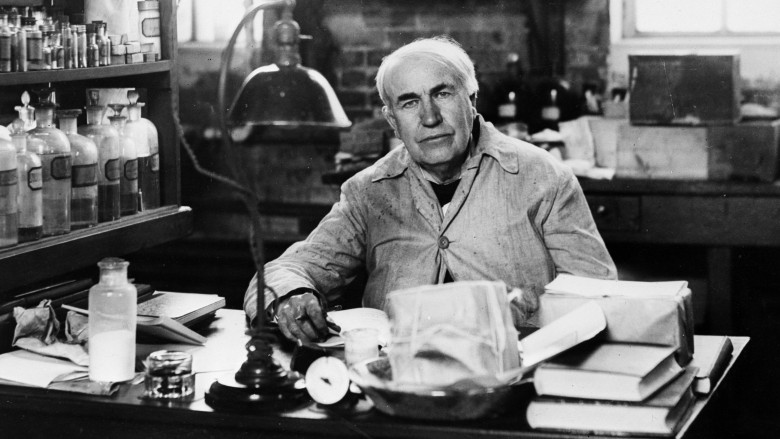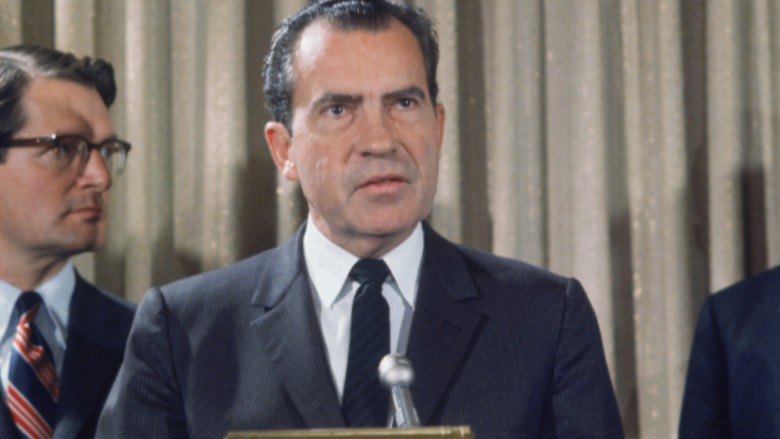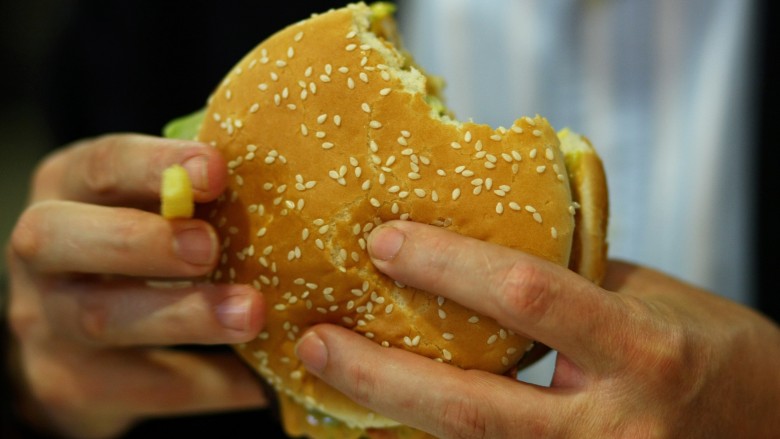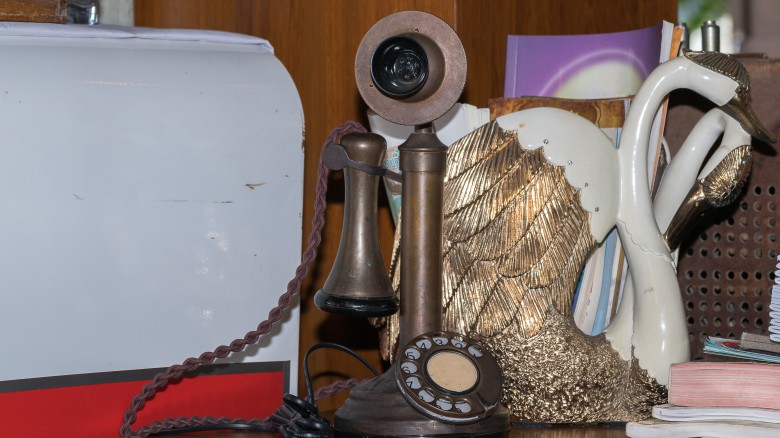The Greatest Pranks Throughout History
One day, long ago, humans learned to communicate. Roughly an hour later, they exploited their newfound gift, by tricking each other into thinking something would happen when it actually never did. And thus did pranking come to be. Some sucked at it, never evolving past "look over there! ... haha, nothing's over there!" Others, meanwhile, took pranking to a different level — a clever, ingenious, almost artistic level that makes you wonder why anybody even bothers telling the boring ol' truth anymore:
William Buckland spells "guano" on his college's lawn, with real guano
Anyone who thinks college kids are a bunch of immature boors these days, and whatever happened to the good ol' times, when proper ladies and gentlemen took their studies seriously, clearly haven't been paying attention. There have been juvenile jackwagons at college since the first bell rang — this is no more evident than the case of WIlliam Buckland and his epic, disgusting prank for the ages.
In 1790, the Oxford student, bored of hearing his history teacher bellyache about those uppity colonies and that damn Benedict Arnold, Washington, for the thousandth time that semester, decided to let out some steam. He did so by gathering buckets upon buckets of bat guano, something only scientists and Batman really bother with these days. He then spread the flying rodent poo across the Oxford lawn, spelling out G-U-A-N-O with it because he was a fancee college kid 2 college n he culd spel gud.
As you'd expect, Oxford officials were less than thrilled, and cleaned up all the bat #2 immediately. But here's what Buckland knew and they didn't — poo is fertilizer. It helps grass grow. And so, after a short while, that part of the grass grew taller and faster than the rest, until G-U-A-N-O was spelled out quite visibly in the grass, allowing all to bask in its childish glory for a good long time. In other words, the guano might've been gone, yet school officials went bat-s*** crazy anyhow.
Someone convinced the world Thomas Edison had invented a "food creator"
After a whole bunch of world-changing inventions, Thomas Edison had become famous enough that people started assuming he was an actual superhero, and his power was inventing literally everything. Artificial light? He could make that. Sounds on a wax cylinder? He could make that. Make Tesla go hungry yet again because Edison got the patents and Tesla didn't? He could do that.
In 1878, the newspaper New York Graphic took advantage of Edison's "he can invent all things" reputation, putting out a fake news release claiming the great stuff-maker had invented a "food creator." It's just what it sounds like. As the apparently copy-editor-less Graphic put it: "Edison invents a machine that will feed the human race! Manufacturing biscuit, meat, vegetables, and wine out of air, water, and common earth." Yes, just one biscuit. And Edison got to eat it, because he was Thomas Edison and the plebeians weren't.
People happily fell for it — no more stinky old grocery stores, hooray! Newspapers from hither to thither sung Edison's praises, as he was the man to finally end world hunger ... except for the one small issue: he wasn't. He didn't invent a food-creating machine. He didn't even say he would — this wasn't his prank, this was entirely cooked up by a newspaper with tons of time to kill, probably because Boss Tweed hadn't done anything corrupt that week.
Alas, the world would not see a food-creating machine until 2009, when the renowned scientist Flint Lockwood gave us one. And unless you like your food raining from the sky and threatening to crush you to death before you can chew, it kinda sucked.
An impersonator made us think Richard Nixon was running for President ... in 1992
In 1974, Richard Nixon did a bad, bad thing, and quit his job before anyone could fire him. Eighteen years later, according to NPR's "Talk of the Nation" show, he apparently had decided to give it another go, and told the radio station he was going to run for president yet again.
This shocked, oh, everybody. For one thing, Richard Nixon was stupendously old at the time (had he won, he would've been just shy of 80). For another thing, he was already elected twice, so according to the Constitution he wasn't eligible to run again. For another thing, he was Richard Nixon. The idea of him being the crook-in-chief yet again was, as you'd expect, appalling to the average American, despite Nixon's soothing new catchphrase: "I never did anything wrong, and I won't do it again."
Even the Republicans went nuts, with the Bush campaign lambasting Nixon's announcement as "an obvious attempt by Nixon to upstage our foreign policy announcement." Or, you know, not, since that wasn't Richard Nixon talking to NPR. A comic named Rich Little had done the voice, and did it well enough that scores were bamboozled. But imagine if it was real, and he had won. He died less than two years later, so the '90s wouldn't just have a Constitutional crisis — we'd have dealt with a president dying in office too, which is rarely good for the economy. Probably a good thing, then, that this was nothing more than a funny ha-ha from the world-renowned rib-ticklers at National Public Radio.
Kjell Stensson claimed you could add color to your black-and-white TV using nylon stockings
In 1962, Sweden loved TV so much, they only had one channel. They must've been super-jealous of the kids in America, spoiled and coddled with three channels like they were. Obviously, this one Swedish channel was in black-and-white, which gave a goof named Kjell Stensson the ammo to pull off an incredible April Fool's prank on the entire country.
He went on TV and told the host of ... whatever their show was called (Bork Bork Bork Meatball Bjork Happy Hour, probably) that he had figured out how to make B&W TV color. All you had to do was place a nylon stocking over the boob tube and *BANG* — pretty, pretty colors. They described it all scientific-like, too — stuff about prisms and the color spectrum and how light shining through holes in the stockings will make colors appear on the screen. Also, you had to tilt your head just so, so the light appears at just the right angle for color to appear.
Doesn't that sound stupid and not true? Of course it does, but that didn't stop Swedish household after Swedish household from falling for it. Thousands of reports came in of kids watching their parents running around the house like rubes, grabbing all the pantyhose they could find and cutting it up and taping it to their TV so they could watch ... whatever the hell they watched back then (probably a lot of downhill skiing). And thus, an entire generation of children learned — the hilarious way — that their parents weren't perfect, but rather were just as dumb as anyone else.
A couple of Miami DJs prank both Hugo Chavez and Fidel Castro
Isn't it hilarious when a radio station's morning-time DJs prank some old lady into saying stupid stuff on the air? Well, no, not really, but it is pretty funny when they do it to despotic heads of state!
Enrique Santos and Joe Ferrero, jocks at a Spanish-language station down in Florida, are experts at doing this. In 2003, they somehow got a direct phone number for Venezuelan president/dictator Hugo Chavez. They "talked" to him via sound bites cobbled together from Cuban president/dictator Fidel Castro's speeches. After awhile, they revealed they were not, in fact, Castro, but rather a couple of jamokes from the Miami area. They yelled at Chavez, "You're finishing off the Venezuelan people!" and then hung up on him before Chavez could even think of declaring war.
A few months later, they did it again, this time direct-dialing Castro. This time, they got Chavez sound bites and communicated with Fidel through those. After a nice, lively conversation about retrieving a missing briefcase, followed by a debate over who could starve their people quicker and more efficiently (probably — our Spanish is rusty), the jocks revealed themselves with the question, "Are you satisfied with [what] you have done on the island, assassin?" Castro reacted like any dignified statesman would — he swore up a storm, insulted the jocks' mothers, and implied they were just so, so gay.
The jocks got fined $3,500, not because they came within inches of starting another Cuban Missile Crisis, but because they hadn't told Castro their call would be on the air and you're not supposed to do that. It's always the ticky-tack stuff that gets you. Al Capone killed countless people and got nabbed on taxes. These guys enraged world leaders and lost money because of Section 3, paragraph 2, line 6 in the Employee Handbook they likely skimmed once, years ago, on the toilet.
Burger King pretended to sell a Whopper just for left-handed folks
Pity the poor left-handed people and their ... inability to hold a burger? That was the basis of Burger King's 1998 fast one on fast food lovers everywhere.
Yep, the burger joint everyone loves when their local McDonald's is being fumigated put out a press release on March 31, 1998, announcing the "Left-Handed Whopper," designed exclusively for lefties. How exactly is a hunk of cow smushed between two squishy bits of baked flour they pretend is a bun hard for left-handers to use, you ask? Well, according to BK, it's all in the placement of the burger itself, which was to be rotated 180 degrees, so lefties could more comfortably eat without spilling everything everywhere. So basically, the south end of your lettuce would now be north, and that's supposed to satisfy the vast left-fingered conspiracy somehow.
Or rather, it would have, if it were real. A day later (April 1, natch), the company announced the Leftie Whopper was bogus. This, of course, came after thousands of customers showed up to order the damned thing. Oh, and right-handed people apparently demanded their OWN hand-specific Whopper, despite that being, you know, the regular Whopper. All of this despite BK's marketing VP reminding us all that you need two hands to hold a Whopper, so come on y'all.
You also need two hands to drive to a better restaurant. Just something to keep in mind next time there's a rumbly in your tumbly.
Pranksters trick Washington U. students into spelling out "Caltech" during the Rose Bowl
1961's Rose Bowl didn't feature the California Institute of Technology (Caltech if you're nasty and/or too busy doing nerdy tech stuff to say the whole name), though the school still managed to make an appearance, through one of the most obsessively detailed pranks ever. You know how a whole section of fans, during games, will flip up cards saying GO TEAM or whatever? Yeah, they screwed with that,pretty much just to say they did.
The plan was for fans of Washington University — a school actually playing in the Bowl — to hold up flip cards at halftime, that would spell out WASHINGTON. A group of Caltech pranksters changed all that, by breaking into the dorm rooms of the Washington cheerleaders who were organizing the Bowl's halftime show. They first did this by disguising themselves as high school reporters, so they could learn about the flip-card plans. Later on, they picked locks and made off with the instructions, so they could make their own cards. Some time later, they broke in AGAIN, this time replacing the real cards with 2,232 of their phony ones. Even later, they broke in YET AGAIN, this time to steal the master plans and replace them with their made-up ones. All this for maybe five seconds of airtime, remember.
But oh, what a wonderful maybe-five seconds it was, when the Washington crowd flipped up their cards to unknowingly spell out CALTECH. The whole country paid attention to the prank, and since attention is really the point of most every prank, the Caltech kids seemingly got exactly what they wanted. Besides, pulling the rug over thousands of people, with a plan that took several weeks just to nail down, sounds way more satisfying than winning some mere game.
Sci-fi writers create the worst novel ever, to see if a scam publisher would accept it. They did
In 2004, a group of professional writers decided to expose free-to-publish gurus PublishAmerica as the scam artists they apparently are. (Lawsuits charge they intentionally sign authors to terrible, unpaying contracts, then refuse to promote the books until the authors order expensive "promotional" packages that likely don't accomplish anything.) They did this by cobbling together their own novel, called Atlanta Nights, submitting it under the pen-name "Travis Tea." It is, indeed a travesty, almost unquestionably the worst book ever written.
They designed it that way, though — each author got a chapter to write, but weren't told of the plot, the setting, the characters' backgrounds, or even where in the book their chapter would appear. Plus, they wrote their chapters like garbage, with typos and cheesy lines galore. The result is, as you might expect, a disjointed, confusing, poorly done mess that PA accepted happily. And who wouldn't, with an epic opening line, "Pain. Whispering voices. Pain. Pain. Pain. Pain. Need pee–new pain–what are they sticking in me? . . . Sleep. Pain. Whispering voices"?
Naturally, PublishAmerica accepted the writers' garbage book almost immediately, extending them the same god-awful contract they extended every wannabe scribe not good enough for Simon and Schuster. Of course, they had no intent of signing anything, and quickly let the world know of the crap that PA gobbles up in the name of scamming the unknowing. Magically, PA retracted their contract offer the next day, citing "Upon further review it appears that your work is not ready to be published. There are portions of nonsensical text in the manuscript that were caught by our editing staff..." which is an awful funny way to say "we got exposed, gotta save face, OH OUR PRECIOUS SCAM."
Wanna read Atlanta Nights for some goofy reason? Here you go. Wanna buy it for some even goofier reason? Here you go. Don't say we — and Travis Tea — didn't warn you.
The 1884 prank phone call that started it all
Prank calls are a dime-a-dozen, and have been for a very long time. But this prankster still deserves a tip of our keyboard for being so quick to the punch. In 1884, less than a decade after Alexander Graham Bell proved to be such a phony, some guy in Providence, Rhode Island decided the very best use of this fantastical new technology was to mess with people.
He did so by dialing up various undertakers and alerting them that people were dead, so please bring candles and coffins over stat. (Funeral folks made incredibly morbid house calls back then, it would seem.) Of course, nobody was actually dead — it was all, as The Electrical World put it — a "grave joke." GEDDIT? Grave joke? Graves? Dead people? Aren't puns just wonderfully immortal?
That kind of puts your typical high school punk who orders pizza for people who didn't actually want pizza to shame, doesn't it? The first crank call, over a hundred years before Bart Simpson thought of it, and it was a doozy. You couldn't get away with it anymore, though. Today's undertakers are simply too big, too mean, and too demonic. Annoy them, and you'll get tossed straight to Hell with naught but a bone-chilling eyeball-roll as the last thing you see.
A guy invents an artist, creates a terrible "abstract" painting, convinces a museum to buy it
Art is subjective, but it does seem like a lot of it is barely any better or more thought-out than a toddler's scribblings, and that museums and pretentious rich people only buy them so they don't look like they don't "get it." A man named Jim Moran certainly proved that, if that's not how every art snob thinks, it sure is how a lot of them do.
In 1946, Moran invented a fake artist named "Naromji" and created a piece of abstract art in his name. It was, as the "artist" himself would admit, terrible — nothing but random shapes and small photos pasted all around, such as fish, body parts, and the eye of comedian Fred Allen. Because this kind of "art" made Moran want to "tear [his] hair," he called it "Three Out Of Five," which was also the name of an old hair-restoring product.
Naturally, the artsy types gushed over it. The LA Times described it as "an astonishing conglomeration of paint, chalk, magazine cut-outs and carmine fingernail polish." What's truly astonishing is that whoever wrote that tripe probably didn't get fired immediately. Meanwhile, the Los Angeles Art Association proudly displayed the painting with a $1,000 price tag — which blew up magnificently in their faces once Moran went public with the truth. We're guessing Moran was no longer the one tearing at hair.
The Art Association's face-saving excuses saved no faces — first, they said they thought that somebody else had painted it, a Dadaist composer named George Antheil. Then, they scolded Moran for fooling them, claiming it'll now become harder for actual artists to sell their work. Then, when some other artist named Leonard Kester claimed he was the painter, the Art Association backtracked and said it was real art, and they were happy to display it. We're not sure if Kester meant it, but his involvement helped make a profound statement about art: nobody understands the stuff, and all you need for people to see you as a serious artist, is to say you are one.








